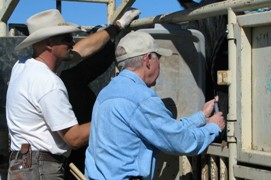For nearly 40 years, the BLM has protected the health and welfare of wild horses and burros to ensure their humane treatment under the federal legislation that established the Wild Horse and Burro Program. Balancing herd numbers with the land’s capacity, handling procedures, facilities, and post-adoption compliance checks were all designed toward this end.
 | The BLM uses the best, most humane methods for capturing and handling wild horses and burros. These methods are based on decades of experience and consultation with animal behavior and veterinary experts. The BLM will continue to look for improvements in safety, efficiency and humane treatment. |
Goal: Use a progressive approach to implement a Comprehensive Animal Welfare Program (CAWP). Develop and implement a CAWP to ensure the well-being of wild horses and burros at gathers and in facilities; ensure compliance with animal care requirements following adoption. The CAWP will bring together existing elements like adoption compliance, with a progression of new components, such as education for employees and contractors; an ongoing, internal animal welfare assessment program; and periodic external reviews of our animal care and handling. Coordinate all components of the CAWP through a new position, the National Animal Welfare Coordinator. Conduct the CAWP with complete transparency.
Objective 1: Develop and implement a Comprehensive Animal Welfare Program (CAWP).
Action:
Use the structured approach successfully implemented by other industries to create a program to assess, monitor and document the BLM humane treatment of animals to the public on an ongoing basis.
Hire a full-time Animal Welfare Coordinator.
Objective 2: Outreach the CAWP within the Wild Horse and Burro Program, to the public and to Congress to demonstrate how it will benefit the animals under our care and the program as a whole.
Actions:
Objective 3: Provide a continuing education program on animal care and handling for employees and contractors.
Action:
Develop learning and training module.
Objective 4: Implement an internal animal welfare assessment program on an ongoing basis.
Actions:
Review the results of the ongoing project to develop a “Wild Horse and Burro Care and Welfare Assessment Tool” (University of California, Davis).
Create a template for assessing the program at all levels.
Develop a rotating schedule and conduct periodic assessments in all BLM states.
Objective 5: Solicit periodic, focused external reviews of animal care and handling at each level of the Wild Horse and Burro Program; gathers, short term holding, long term pastures, adoption and compliance.
Action:
Solicit review from the American Association of Equine Practitioners for gathers and short term holding facilities.
Objective 6: Increase level of veterinary support through the current Animal Plant Health Inspection Service (APHIS)/BLM wild horse and burro partnership for all helicopter gathers.
Actions:
Establish a training module and Standard Operating Procedures for APHIS veterinarians supporting the wild horse and burro partnership.
Investigate partnerships with other veterinarian organizations to provide additional support to the program.
Objective 7: Report to the public and Congress regarding the welfare of all the animals under our care.
Actions: